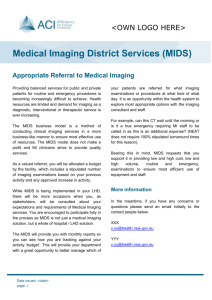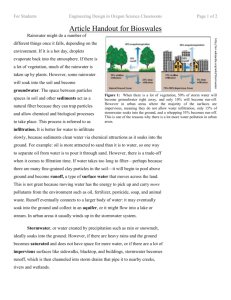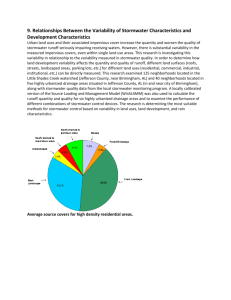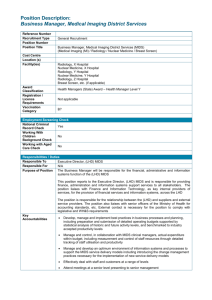1_-_MIDS_Addendum_Sections1and2_final
advertisement
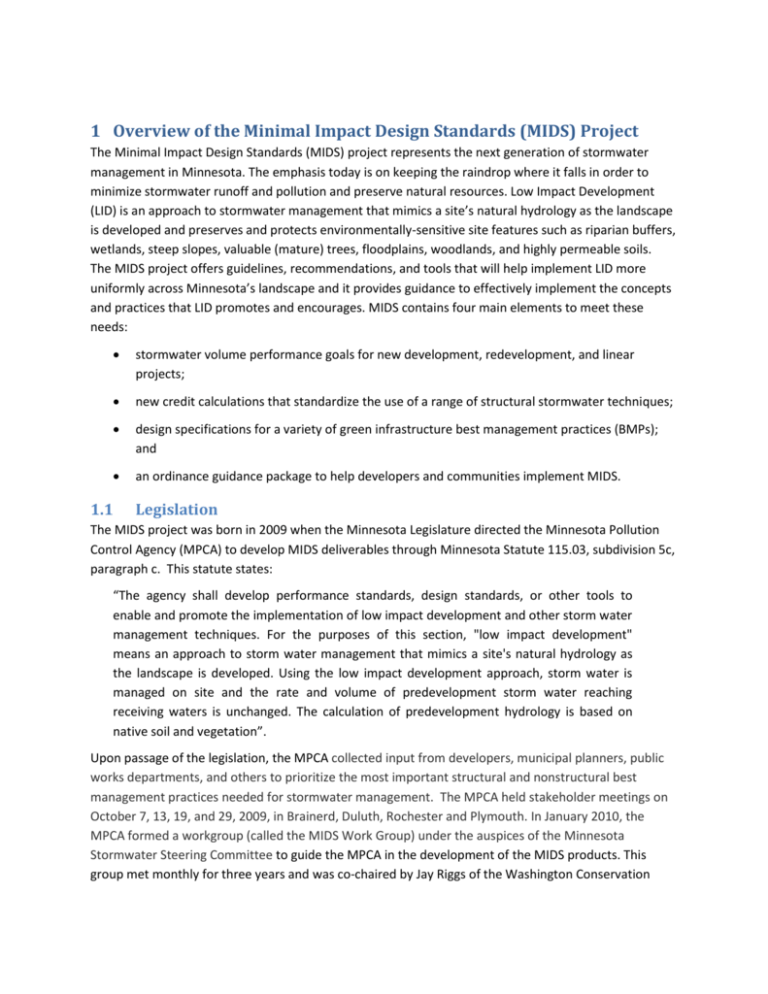
1 Overview of the Minimal Impact Design Standards (MIDS) Project The Minimal Impact Design Standards (MIDS) project represents the next generation of stormwater management in Minnesota. The emphasis today is on keeping the raindrop where it falls in order to minimize stormwater runoff and pollution and preserve natural resources. Low Impact Development (LID) is an approach to stormwater management that mimics a site’s natural hydrology as the landscape is developed and preserves and protects environmentally-sensitive site features such as riparian buffers, wetlands, steep slopes, valuable (mature) trees, floodplains, woodlands, and highly permeable soils. The MIDS project offers guidelines, recommendations, and tools that will help implement LID more uniformly across Minnesota’s landscape and it provides guidance to effectively implement the concepts and practices that LID promotes and encourages. MIDS contains four main elements to meet these needs: stormwater volume performance goals for new development, redevelopment, and linear projects; new credit calculations that standardize the use of a range of structural stormwater techniques; design specifications for a variety of green infrastructure best management practices (BMPs); and an ordinance guidance package to help developers and communities implement MIDS. 1.1 Legislation The MIDS project was born in 2009 when the Minnesota Legislature directed the Minnesota Pollution Control Agency (MPCA) to develop MIDS deliverables through Minnesota Statute 115.03, subdivision 5c, paragraph c. This statute states: “The agency shall develop performance standards, design standards, or other tools to enable and promote the implementation of low impact development and other storm water management techniques. For the purposes of this section, "low impact development" means an approach to storm water management that mimics a site's natural hydrology as the landscape is developed. Using the low impact development approach, storm water is managed on site and the rate and volume of predevelopment storm water reaching receiving waters is unchanged. The calculation of predevelopment hydrology is based on native soil and vegetation”. Upon passage of the legislation, the MPCA collected input from developers, municipal planners, public works departments, and others to prioritize the most important structural and nonstructural best management practices needed for stormwater management. The MPCA held stakeholder meetings on October 7, 13, 19, and 29, 2009, in Brainerd, Duluth, Rochester and Plymouth. In January 2010, the MPCA formed a workgroup (called the MIDS Work Group) under the auspices of the Minnesota Stormwater Steering Committee to guide the MPCA in the development of the MIDS products. This group met monthly for three years and was co-chaired by Jay Riggs of the Washington Conservation District (2010-2013), Mark Doneux of the Capitol Region Watershed District (2010-2011) and Jim Hafner of the City of Blaine (2012-2013). The Work Group included: Organization Primary Alternate City-metro Phase 1 MS4 Lois Eberhart Phil Belfiori/Anne Weber/ Wesley Saunders-Pearce Minnesota Pollution Control Agency Mike Findorff Anne Gelbmann City-metro Phase II/MS4 (MCSC) James Hafner Scott Anderson Soil and Water Conservation District (Metro) Jay Riggs Mike Isensee Soil and Water Conservation District (Greater Minnesota) Wayne Cymbaluk Mark Zabel Builders Association James Vagle Lisa Frenette Metropolitan Council Karen Jensen Jack Frost/Joe Mulcahy Non Point Education for Municipal Officials Julie Westerlund/Jesse Schomberg American Public Works Assn/Mn Chapter Klayton Eckles Kerry Thorne Developer Larry Frank Bob Engstrom/Ian Peterson Metro Watershed District Tina Carstens Forrest Kelley Watershed Districts-Greater Minnesota Chad Anderson Mike Kinny/Doug Thomas Minnesota Nursery and Landscape Assn. Robert Race Craig Otto/Tim Malooly Watershed Management Organizations Paul Moline Doug Snyder Minnesota Department of Natural Resources Peder Otterson/Julie Westerlund Paul Radomski Minnesota Department of Transportation Wesley SaundersPearce/Bruce Irish/Beth Neuendorf Beth Neuendorf/Nicklas Tiedeken Academic Researcher Shane Missaghi Non-profit Trevor Russell Liz Boyer/Vanessa Perry Board of Soil and Water Resources Melissa Lewis Steve Woods City-greater MN-MS4 Matt Durand Anita Rasmussen Engineering Consultant Michele Caron Randy Hedlund Minnesota County Planning and Zoning Administrators Garry Johanson Minnesota Utilities Contractors Association Deann Stish Association of Landscape Architects (Minnesota Chapter) Joni Giese NAIOP, the Commercial Real Estate Development Association David Bade Mary Davy Dennis Sutliff Other members of the MIDS Work Group included: Representing Name Role Minnesota Department of Natural Resources Ken Holman Alternate Minnesota Department of Natural Resources Sharon Pfeifer Alternate Developer Dave Newman Alternate Minnesota Chapter of APWA Rick Person Alternate Minnesota Pollution Control Agency Anna Kerr Alternate Engineering Consultant Roger Anderson Alternate Minnesota Chapter of APWA Sherri Buss Advisory U.S. Environmental Protection Agency Bob Newport Advisory Builders James Vagle Founding Partner Business and Industry Lisa Frenette Founding Partner Minnesota Center for Environmental Advocacy Kris Sigford Founding Partner League of Minnesota Cities Craig Johnson Founding Partner Minnesota Pollution Control Agency Rebecca Flood High Level Review Metro Association of Watershed Districts Ray Bohn High Level Review 1.2 Objectives The MIDS project centers on promoting LID as an approach to mimic a site’s natural hydrology. The primary goal is to have developments achieve a post-development runoff rate and volume equivalent to a site’s natural hydrology, where the natural hydrology of the site is based on native soils and vegetation. The stakeholder group identified other goals for MIDS, including, but not limited to 1.3 creating simple performance goals; encouraging local units of government to adopt the performance goals so that a unified approach is adopted throughout the state; incentivizing the adoption of MIDS by having MIDS increase the likelihood of conforming with federal and state requirements (e.g., NPDES permit requirements); quantifying the benefits of various BMPs in terms of volume, total phosphorus, dissolved phosphorus, and total suspended solids; and assisting in complying with Total Maximum Daily Load (TMDL), Municipal Separate Storm Sewer System (MS4) permit, Construction Stormwater permit, and Outstanding Resource Value Waters (ORVW) program requirements. How MIDS will be used MIDS was specifically developed for designers, engineers, planners, contractors, elected officials, stormwater managers, landscape architects, public works staff, landscape industry, land use regulators and others involved in new development and redevelopment projects that potentially generate stormwater runoff. The concepts behind MIDS can essentially be used by all Minnesotans – we can all do our part in minimizing stormwater runoff and pollution. MIDS methodologies provide tools for individuals to quantify reductions in post-development runoff and pollutant loading from a wide variety of LID practices. Adapting and using LID approaches offers multiple benefits, including minimizing and reducing the amount of pollution reaching our lakes, rivers and streams, and helping to recharge groundwater resources. MIDS establishes unified LID standards, approaches and credits so we can consistently apply these principals across Minnesota communities. MIDS helps communities measure progress toward water and natural resource protection and restoration goals. MIDS will also be used as the highest standard for meeting the stormwater practice for Minnesota Green Step Cities. Specific examples of how the MIDS package can be used, including the MIDS calculator, include the following: Increase the likelihood of compliance with NPDES stormwater permits or other local requirements for managing stormwater. Examples include: o reporting on Total Maximum Daily Loads; o meeting post-construction stormwater management requirements in the Municipal Stormwater General Permit; and o meeting permanent treatment requirements in the Construction Stormwater General Permit. Qualify as a Green Step city. MIDS is considered to meet the highest standard for stormwater practices. Qualify for Blue Star Award. The Blue Star Award is a certification and award program that offers municipalities that excel in stormwater management the positive public recognition they deserve. Provide greater involvement in voluntary initiatives, such as Complete Streets. Quickly and easily quantify the benefit of a Best Management Practice by using the MIDS calculator. Provide documentation on grant applications, such as the Clean Water Legacy grants, to show reductions in TP and TSS. 2 MIDS Performance Goals A performance goal specifies what level of stormwater treatment must be achieved. The MIDS performance goals were developed to satisfy the legislation by determining how much precipitation must be retained on a particular site. 2.1 New Development Sites without Restrictions An important objective of the Work Group was to determine a performance goal for new development sites that do not have restrictions. Restrictions refer to site factors that prevent attainment of the performance goal. Examples of site restrictions include shallow depth to bedrock, presence of contaminated soils, and lack of access due to presence of utilities. In deciding a performance goal for new development without restrictions, the Work Group began by identifying and discussing the pros and cons of three common approaches to consider as the MIDS performance goal approach. Those approaches involved retainage of a runoff volume equal to an amount (e.g., X inches) times the proposed impervious surfaces; equivalent to the post-runoff volume on site for the 95th percentile storm, which is approximately 1.4 inches in the Minneapolis-St. Paul metro area; or necessary to match the native runoff volume for a design storm (e.g., not allow an increase in the runoff volume from the X-year 24-hour design storm). To help the Work Group select a performance goal that would mimic a site’s natural hydrology, the approaches were assessed in comparison with runoff rate and volume from native soil and vegetation conditions. The goal of the assessment was to answer the question, “How well do the performance goal alternatives mimic natural hydrology?” Details of the methods, results, and conclusion of the analyses are included in a report, Assessment of MIDS Performance Goal Alternatives: Runoff Volumes, Runoff Rates, and Pollutant Removal Efficiencies (Barr Engineering Co., 2011; http://www.pca.state.mn.us/index.php/view-document.html?gid=15664) Long-term continuous simulation XP-SWMM models, developed for three regions of Minnesota (Twin Cities, Southeast and North-Central), estimated the runoff from a 10-acre site with native soils (Hydrologic Soil Group A, B, C, and D) and native vegetation (100 percent deciduous woods and 100 percent meadow). Long-term continuous XP-SWMM models of the same three Minnesota regions also simulated the effectiveness of implementing different volume control performance goals on development scenarios of varying imperviousness and soil type. Between twenty-six and thirty-five years of measured precipitation data with a time increment of 15 minutes was used in the modeling effort. Precipitation in the form of rain and snow on frozen and unfrozen ground conditions was modeled to determine the effectiveness of common volume control performance goals on annual runoff (Barr Engineering Co., 2010). Performance goals were assessed based on estimated total phosphorus (TP) and total suspended solids (TSS) removal efficiency on an average annual basis. The portion of average annual runoff volume captured onsite varies depending on the performance goal and resulting BMP volume. While strongly correlated with the amount of runoff captured and infiltrated, the overall pollutant removal efficiency is also dependent on other factors such as the varying concentration of pollutants in runoff (such as the “first flush effect”) and pollutant removal that occurs through sedimentation or other mechanisms. Six of the Twin Cities region development scenarios were modeled using P8 modeling software to evaluate the overall average annual phosphorus and total suspended solids removal efficiencies expected from the four performance goals (Barr Engineering Co., 2010). Those four performance goals included retainage of a runoff volume equal to 1.0 inches times the proposed impervious surfaces; equivalent to the post-runoff volume on site for the 95th percentile storm, which is approximately 1.4 inches in the Minneapolis-St. Paul metro area; necessary to match the native runoff volume to the 1-year 24-hour design storm (e.g., not allow an increase in the runoff volume from the 1-year 24-hour design storm); and necessary to match the native runoff volume to the 2-year 24-hour design storm (e.g., not allow an increase in the runoff volume from the 2-year 24-hour design storm). Table 3-1 of the 2011 Barr Engineering report summarizes the various development scenarios and Minnesota regions modeled with XP-SWMM and P8. The following conclusions are based on the XP-SWMM and P8 modeling results: Rate and volume control Best Management Practices (BMPs) are needed to mimic native hydrology from developed conditions. Developed sites without volume control BMPs produce approximately two to four times the average annual runoff volume of native conditions. All of the volume control performance goals evaluated do well at matching native conditions on an average annual basis. Volume control BMPs controlled the 1-year, 24-hour peak rates to flows less than or equal to native conditions for most scenarios evaluated. Volume control performance goals result in significant pollutant loading reduction from developed sites. All volume control performance goals evaluated have similar removal efficiencies for TP and TSS. The BMP size required to match native runoff volumes on an average annual basis varied with soil type, impervious percentage, and region of the state. The Work Group discussed the modeling results and considered the level of simplicity, incentive to reduce impervious surfaces, and accounting for different regions of the state for each modeling approach. After a vote, the Work Group selected an approach that would retain a runoff volume equal to an amount times the proposed impervious surfaces. The Work Group decided that one value would be best rather than varying the value by soil type, impervious surface percentage, and location within the state. They selected 1.1 inches as the statewide average. In April 2011, the Work Group unanimously agreed on the following performance goal: For new, nonlinear developments that create more than one acre of new impervious surface on sites without restrictions, stormwater runoff volumes will be controlled and the post- construction runoff volume shall be retained on site for 1.1 inches of runoff from impervious surfaces statewide. 2.2 Re-Development Sites without Restrictions In the summer of 2011, the MPCA and MIDS Work Group created a MIDS Re-development and Linear Subcommittee. This group consisted of Forrest Kelly, Tina Carstens, Karen Jensen, Lois Eberhart, Beth Neudendorf, Doug Snyder, Mary Dave, Joe Mulcahy, Randy Neprash, Wes Saunders-Pearce, Brandon Champeau, Jim Hafner, Nick Tiedeken, Bruce Wilson, and Todd Smith. This group evaluated the feasibility of various potential performance goals for re-development sites without restrictions. In June 2013, the group recommended that the MIDS Work Group agree to the following performance goal for redevelopment sites without restrictions: Nonlinear redevelopment projects on site without restrictions that create one or more acres of new and/or fully reconstructed impervious surfaces shall capture and retain on site 1.1 inches of runoff from the new and/or fully reconstructed impervious surfaces. The MIDS Work Group agreed with the subcommittee’s recommendation. 2.3 Linear Projects without Restrictions In June 2013, the MIDS Re-development and Linear Subcommittee recommended a performance goal for linear projects without restrictions to the MIDS Work Group. After much discussion, the MIDS Work Group agreed to the following performance goal. Linear projects on sites without restrictions that create one acre or greater of new and/or fully reconstructed impervious surfaces, shall capture and retain the larger of the following: 0.55 inches of runoff from the new and fully reconstructed impervious surfaces 1.1 inches of runoff from the net increase in impervious area Mill and overlay and other resurfacing activities are not considered fully reconstructed. 2.4 Sites with Restrictions While reducing the volume of stormwater runoff leaving a developed site is the only way to mimic native hydrology, there are situations where attainment of the performance goal is not feasible. For example, infiltration is the most common practice to reduce runoff volumes, but much of Minnesota has tight clay soils, shallow bedrock, or karst topography that are not conducive to infiltration as a stormwater management approach. Other restrictions include but are not limited to sites that have contaminated soil or shallow groundwater, existing building or utility conflicts, or other site constraints such as zoning requirements that create difficulties in providing volume reduction. In order to accommodate alternative forms of water quality treatment on sites with restrictions, the MIDS Work Group, with the assistance of the Re-development and Linear Subcommittee, developed Flexible Treatment Options and an accompanying Design Sequence Flow Chart to help determine the appropriate performance goal. Using the flowchart, project proposers are taken through a step by step approach to document site restrictions and how they have attempted to meet the 1.1 inches performance goal. If the performance goal is shown to be infeasible, a 0.55 inch performance and a 75 percent annual total phosphorus removal goal is explored, followed by a maximum extent practicable volume reduction and a 60 percent annual total phosphorus removal goal, and then a final option to meet the 1.1 inches volume reduction goal at an off-site location. More detailed information regarding the Flexible Treatment Options and definitions are included on the Design Sequence Flow Chart.





